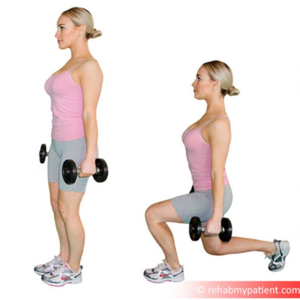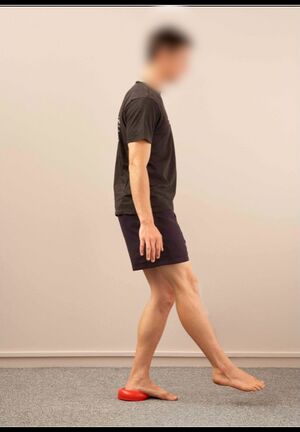Neuromuscular Exercise Program NEMEX
Original Editor - PARIVESH KUMAR
Top Contributors - PARIVESH KUMAR, Lucinda hampton, Kim Jackson, Rucha Gadgil, Rachael Lowe and Aminat Abolade
Introduction[edit | edit source]
The neuromuscular exercise (NEMEX) program is aimed at improving sensorimotor control and attaining functional joint stabilization by addressing the quality of movement in all three movement planes. In patients with mild to severe pain with activity, the NEMEX is program feasible. The jumping activities however were deemed not feasible in 2017 clinical trial.[1]
- It is part of the GLA:D® program (Good Life with Arthritis: Denmark), an education and exercise program developed by researchers in Denmark for people with hip or knee osteoarthritis (OA) symptoms.
- The GLA:D program is an eight week program that includes education and exercise. The program is overseen by a certified GLA:D physiotherapist, with the aim to help patients manage their OA symptoms.
Key Facts
- Feasible in patients with severe hip and knee joint replacement surgery
- Improves function and quality of life
- Reduces pain (associated with reduction in use of analgesia) and sick leave[2]
NEMEX Program[edit | edit source]
In brief the NEMEX program comprise 11 exercises (predominantly performed in a closed kinetic chain) focusing on the following components:
- Correct functional performance and alignment ie being with the knee is lining up over the second toe without tending to fall in medially during knee flexion.
- Postural control: Performing voluntary movements without losing one's posture.
- Strength of lower extremity
- Balance
- Functional stability of the trunk and knee.
The exercises
- Are performed with each leg but focus on the affected leg.
- Allow for progression, 4 levels of difficulty are available
- Progress when the physiotherapist considered that an exercise can be performed with good sensorimotor control and good quality (by visual inspection) and patients perceived that they could perform the movement with minimal exertion and with control of the movement.[1]
- They are usually multi-joint exercises performed in functional closed chain weight-bearing positions.
This 3 minute video outlines the NEMEX program. In summary
- Training occurs groups, with an experienced physical therapist supervising
- Consists of three parts: warming up, a circuit program, and cooling down
- Training session are 60 minutes long.
- The movement quality in each exercise is important, with an appropriate position of the joints in relation to each other, i.e., with the hip, knee and foot well aligned.[3]
The rationale for Neuromuscular Exercises[edit | edit source]
Neuromuscular control is defined as the unconscious trained response of a muscle to a signal regarding dynamic joint stability. The movements of the lower extremity, including the knee joint, are controlled through this system, which needs to provide the correct messaging for purposeful movement[5]. Neuromuscular training programs should address several aspects of sensorimotor function and functional stabilization to improve objective function and alleviate symptoms.
Neuromuscular exercise:
- Addresses the quality of movement and emphasizes joint control in all three biomechanical/movement planes.[5]
- Has effects on functional performance, biomechanics, and muscle activation patterns of the surrounding joint musculature[6].
- Address the lag in neuromuscular reaction time that results in dynamic joint instability with recurrent episodes of joint subluxation and deterioration.[7]
Mechanisms for Sensorimotor Deficiency[edit | edit source]
Sensorimotor dysfunctions may play a role in the development and progression of degenerative joint disease[8].
Impairments are present at different levels of the sensorimotor system from:
- Sensory input, integration and processing of information in the central nervous system
- Motor output (vital to perform voluntary movements and maintain postural control)
- Neural inhibition (caused by factors such as pain, swelling, inflammation, joint laxity, damage to sensory receptors in the joint) prevent the muscles to be activated fully likely through altered excitability of spinal and supraspinal pathways.[9]
- Sensorimotor deficiencies are also found in the non-injured leg, possibly due to physical inactivity after the injury, inherently poor function, and/or disturbed sensory feedback from the injured joint with an inhibitory effect of muscle activation also on the non-injured side.
References[edit | edit source]
- ↑ 1.0 1.1 Clausen B, Holsgaard-Larsen A, Roos EM. An 8-week neuromuscular exercise program for patients with mild to moderate knee osteoarthritis: a case series drawn from a registered clinical trial. Journal of Athletic Training. 2017 Jun;52(6):592-605. Available: https://www.ncbi.nlm.nih.gov/pmc/articles/PMC5488851/(accessed 28.5.2022)
- ↑ Trek NEMEX Available:https://nemex.trekeducation.org/ (accessed 28.5.2022)
- ↑ Glad Australia NEMEX-TJR training program Available:https://gladaustralia.com.au/wp-content/uploads/2018/09/Ageberg-et-al-Appendix-Feasibility-NEMEX-TJR-2010.pdf (accessed 26.11.2022)
- ↑ Target Physio GLA:D Hip and Knee Osteoarthritis Info Video Available:https://www.youtube.com/watch?v=-Xkiad0x7_I(accessed 28.5.2022)
- ↑ 5.0 5.1 Ageberg E, Link A, Roos EM. Feasibility of neuromuscular training in patients with severe hip or knee OA: the individualized goal-based NEMEX-TJR training program. BMC musculoskeletal disorders. 2010 Dec;11(1):126.
- ↑ Clausen B. Neuromuscular exercise as treatment for knee osteoarthritis in middle aged patientsNeuromuscular exercise as treatment for knee osteoarthritis in middle aged patients(Doctoral dissertation), Syddansk Universitet. Det Sundhedsvidenskabelige Fakultet).
- ↑ Risberg MA, Mørk M, Jenssen HK, Holm I. Design and implementation of a neuromuscular training program following anterior cruciate ligament reconstruction. Journal of Orthopaedic & Sports Physical Therapy. 2001 Nov;31(11):620-31.
- ↑ Ageberg E, Roos EM. Neuromuscular exercise as treatment of degenerative knee disease. Exercise and sport sciences reviews. 2015 Jan 1;43(1):14-22.
- ↑ Rice DA, McNair PJ. Quadriceps arthrogenic muscle inhibition: neural mechanisms and treatment perspectives. InSeminars in arthritis and rheumatism 2010 Dec 1 (Vol. 40, No. 3, pp. 250-266). WB Saunders.








